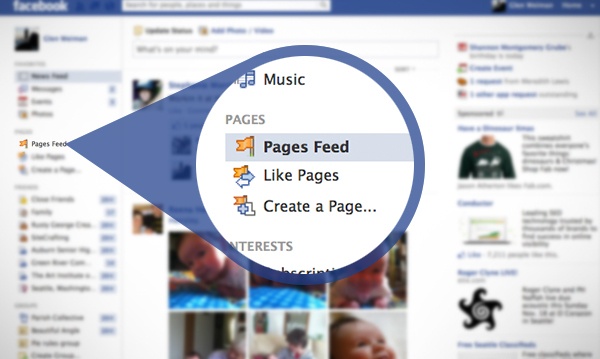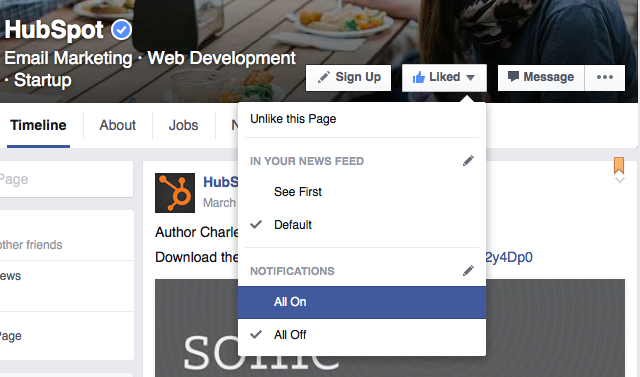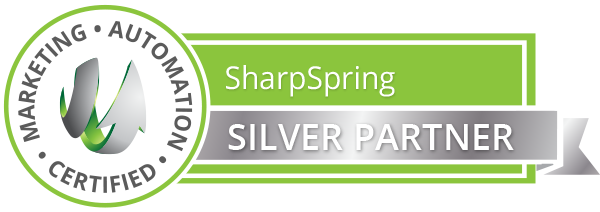
If you’ve been managing a Facebook Page over the past few years, you’ve likely noticed a drop in how many of your fans have been viewing and interacting with your organic posts. This decline in organic Facebook reach came to a head in 2014, when marketers started picking up on (and complaining about) the situation in droves, prompting a response from Facebook’s VP of Advertising Technology, Brian Boland.
“Over the past few months, I’ve read articles and answered questions from many people who are concerned about declines in organic reach for their Facebook Pages,” Boland wrote in June of 2014.
He continued, “My colleagues and I at Facebook understand that this has been a pain point for many businesses, and we’re committed to helping you understand what’s driving this change … “
The two main reasons Boland cited for the organic reach decline? First, there’s simply too much content being published on Facebook, making visibility in the News Feed increasingly competitive. Second, Facebook is deliberately trying to show people the content that is most relevant to them, as opposed to surfacing all the content available.
The good news in all of this is that there’s a lot you can do to counteract these changes, like being more selective about what you publish and/or throwing some money behind your posts (a.k.a. “boosting” them).
Download our free Facebook guide here for more tips on maximizing your Facebook reach.
Before we dive deeper into how you can improve your Facebook Page’s organic reach, let’s explore exactly what happened during the Great Organic Reach Decline of 2014, and how Facebook decides what content gets surfaced nowadays.
How (And Why) Facebook Reach Has Declined Over Time
Facebook defines organic reach as “how many people you can reach for free on Facebook by posting to your Page.” Prior to 2012, that number used to be much, much higher than it is now.
From the moment “Fan Pages” launched in 2007, anyone could create a Page for their company or organization, start collecting fans, and post unlimited messages to their fan bases with the assumption that they would see those messages. But when 2012 rolled around, Page managers learned that only a fraction of their Facebook fans — 16% on average — were seeing their Page posts in their News Feeds. And that fraction has only gotten smaller and smaller since.
A study from Edgerank Checker found that between February 2012 and March 2014, organic reach for the average Facebook Page dropped from 16% to 6.5%. Research from Social@Ogilvy, meanwhile, suggests that for Pages with more than 500,000 Likes, organic reach could be as low as 2%.
Based on the figures above, that means a Page with 10,000 fans could expect just 650 of them to actually see that Page’s posts in their News Feeds. For a Page with 1 million fans, about 20,000 would end up seeing posts (based on the 2% figure).
Fewer people seeing your Page’s organic posts on Facebook means fewer clicks, comments, and shares. And having fewer of those interactions means fewer conversions, leads, and customers. Understandably, this has annoyed the crap out of many-a Facebook Page manager. So why would Facebook decide to decrease organic post visibility in the first place?
I already touched on Facebook’s official response to this question in the introduction: There are simply too many Pages producing too much content for too many fans, which means competition for visibility on the News Feed is high. What’s more, Facebook is trying to make sure people are only seeing the best content — the stuff that is relevant to them.
But many in the marketing world suspect that Facebook had (and still has) an ulterior motive: To get people to start spending more on ads.
More Money = More Visibility
As Facebook has evolved into more of a paid marketing platform than an organic one, Page managers are realizing they’re now expected to pay for ads yet again to reach those newly acquired Fans, even if those Fans have seemingly elected to see a brand’s posts by liking their Page in the first place.
In a 2014 interview with Digiday, James Del (who was the head of Gawker’s content studio at the time) summed up the general sentiment:
Facebook may be pulling off one of the most lucrative grifts of all time; first, they convinced brands they needed to purchase all their Fans and Likes — even though everyone knows you can’t buy love; then, Facebook continues to charge those same brands money to speak to the Fans they just bought.”
Of course, Facebook has denied that this is the case. Boland even had a section in his 2014 organic reach update post titled, “Is organic reach dropping because Facebook is trying to make more money?” Boland’s response:
No. Our goal is always to provide the best experience for the people that use Facebook. We believe that delivering the best experiences for people also benefits the businesses that use Facebook. If people are more active and engaged with stories that appear in News Feed, they are also more likely to be active and engaged with content from businesses.”
From Facebook’s perspective, it’s simply not an ideal user experience to flood the News Feed with posts just because a Page has lots of Likes and is publishing prolifically.
Nowadays, Facebook is encouraging marketers to look at their fan bases as a way to make paid advertising more effective rather than using it as a free broadcast channel. Additionally, Facebook says you should assume organic reach will eventually arrive at zero. So, if you really want to reach your target audience on Facebook, you’ll need to supplement your organic efforts with some paid advertising.
Additionally, Facebook advises marketers to expect things to keep changing, and often times for the better. Facebook has never been stagnant in terms of innovation, so no marketer can figure out a formula and then stick with it forever.
That being said, knowing how Facebook currently surfaces organic content in the News Feed can be helpful for understanding the broader Facebook marketing ecosystem.
How Facebook’s News Feed Algorithm Works
When Facebook first launched News Feed back in 2006, the algorithm was pretty basic. Different post formats were assigned different point values — so a post with just text might be worth one point, while a post with a link in it might be worth two points, and so on. By multiplying the post format point value by the number of people interacting with a given post, Facebook could generate a ranking system for determining the order in which posts would appear.
As the years rolled on, the News Feed algorithm evolved to factor in the recency of posts, as well as the relationship between the person doing the posting and the person interacting with said post. This iteration of the algorithm was known as EdgeRank. But in 2011, Facebook abandoned EdgeRank for a more complex algorithm that incorporates machine learning.
That machine learning-based algorithm is what’s responsible for surfacing content on your News Feed today. Unlike its predecessors, which assigned generic point values to post formats, the current algorithm adapts to individual user preferences. So, for example, if you never, ever, interact with photos in your News Feed, Facebook’s algorithm will pick up on that and show you fewer photos over time.
Ultimately, there are thousands of factors that inform Facebook’s algorithm, which range from using trigger words that indicate important events (e.g., “congratulations”) to whether or not you’ve actually clicked a link in a post before liking it.
Facebook’s end goal here is to have its algorithm match News Feed content to the individual needs and interests of each and every user. As Facebook’s Chief Product Officer, Chris Cox, told Time in a 2015 interview:
If you could rate everything that happened on Earth today that was published anywhere by any of your friends, any of your family, any news source…and then pick the 10 that were the most meaningful to know today, that would be a really cool service for us to build. That is really what we aspire to have News Feed become.”
How to Deal With Declining Organic Reach
Now that you’ve got a better understanding of how Facebook surfaces content, let’s explore some tips for dealing with the decline in organic Page reach.
1) Be more selective about what you post.
Marketers have to switch gears from untargeted, frequent publishing to targeted, selective publishing. The goal is no longer to spray and pray — it’s to get as much interaction from a single post as possible. Each post published to a brand Page can be targeted to a specific audience regardless of whether or not it’s sponsored, which may improve overall interaction with that post among other people who are likely to find it more interesting and relevant.
2) Remind your Fans they can go to Pages Feed on the left sidebar of their News Feed to see content from Pages they’ve Liked.

3) Educate your super fans that they can update their notification settings from your Page.

4) Encourage fans to engage with your posts when they do see them, so they see more of them.
This can be as simple as adding a reminder to “Please Like and share” at the end of your posts.
5) Re-allocate your time and effort toward your owned assets.
Since the only constant with Facebook (and the larger digital media landscape) is change, it’s always safest to focus on the digital channels you entirely own and control — your website and blog. Spend the vast majority of your effort creating content (blog posts and long-form content such as ebooks, case studies, or videos) that will continue to garner inbound traffic, leads, and customers long after they’re first created. If you have time and budget, share those assets to Facebook for additional reach.
6) Start treating Facebook like a paid ad platform.
If you’re going to pay-to-play, get your targeting right. Once you’ve built an audience of relevant fans, focus on advertising the content assets you’ve created — blog posts, ebooks, etc. — and use ads to amplify them to targeted users. Remember: It’s likely only a matter of time before organic reach hits zero, so you might as well hone your paid strategy now, which brings me to one final recommendation …
7) If you do advertise, go beyond the basics.
Facebook’s targeting capabilities have gotten considerably better over the past few years. You can now pay to reach your ideal persona based on demographics, interests, web behavior, and more. Additionally, there are a bunch of tools and features that can help you maximize the effectiveness of your campaigns, including …
- Conversion Tracking: Track the actions of site visitors after viewing your Facebook ad.
- Custom Audiences: Target Facebook ads based on your email list.
- Lookalike Audiences: Target Facebook users similar to your customers.
- Audience Insights: Learn about your existing Facebook audience to better target your ads.
- Website Custom Audiences: Target Facebook users who have visited your website before.
- Facebook Exchange: Place retargeted ads on Facebook for users who’ve visited a certain product or service page on your site.
- Lots and Lots of Customizable Reporting: Create reports based on metrics that matter most for your business.
To learn more about how you can improve your Facebook Page’s reach, check out our free guide: How to Attract Customers with Facebook.
Your turn! What are your thoughts and experiences with Facebook’s organic reach decline? How has it affected your inbound marketing strategy?
Editor’s Note: This post was originally published in June 2014 and has been updated and for freshness, accuracy, and comprehensiveness.
![]()



